ALTE DOCUMENTE
|
|||||
Для клиентов (слушателей) вполне достаточно любого мультимедийн 636j918g ;ого плейера, который поддерживает потоковый прием, проще сказать, тот, который содержит на своем борту подстановку URL для прослушивания онлайнового вещания. Никаких дополнительных софтовых довесков им не потребуется.
sc_serv_gui.ini sc_serv.ini ini exe-шником
(кстати, это
весьма
удобно, если
Вы планируете
запитать на
одном
компьютере несколько
серверов
потокового
вещания, достаточно
задублировать
exe-шники под
другими
именами и,
соответственно,
под каждый
так же
создать
файлы
инициализации).
После этого
редактируем
содержимое
файла.
Параметров в
нем много, но
для начала достаточно
минимума.
Ниже привожу
настройку
основных
позиций конфигурации
сервера,
которых
вполне
достаточно
для запуска
проекта по
локальной
сети.
|
MaxUser= | |
|
Password= | |
|
PortBase= |
ini sc_serv.exe
Тут пытливый читатель и ярый поклонник работы в окнах с мышкой, может упрекнуть меня в том, что настроить конфигурационный файл можно и из кожуры программы. Я с этим согласен, просто привык все делать руками в командной строке (в частности для правки конфигов я пользуюсь файловым менеджером Far, ну не люблю я, так называемый, блокнот). Опять же, если Вы поправите конфиг из самой программы, то после этого потребуется выполнить Kill Server

В
открывшемся
окне, видны
основные
параметры
того, как
настроена и
будет
работать серверная
часть
потокового
вещания.
Образно, эту
программу
можно
назвать
"передатчиком"
т.к. именно
она будет
"вливать"
данные в
сеть.
На этом, пока
можно
оставить
серверную
часть в покое
(пусть
болтается
запущенным) и
перейдем к
программному
обеспечению,
которое
можно
упрощенно
назвать
"частный DJ".
Установите плагин к WinAMP-у, запустите сам плейер, нажмитете Ctrl+P DSP/Effects Nullsoft SHOUT cast Source DSP

Закладка Output

При активированной кнопке Connection, у Вас должны быть доступны следующие параметры настройки (наглядно все показано на скриншоте выше).
|
Connect at Startup | |
|
Address |
введите IP адрес компьютера, на котором установлен сервер потокового вещания. |
|
Port | |
|
Password | |
|
Encoder |
пока пусть будет 1. В дальнейшем, Вы сможете на каждую позицию выставить режим вещания (mono/stereo) и определенный битрейт. |
|
Automatic Reconnection on Connection Failure | |
|
Reconnection Timeout |
Yellowpages

Yellow Pages Configuration -
предоставляет
вывод Ваших
данных у
клиента.
Если Ваша
станция
вещает в
Интернет, то
это возможность
автоматического
опубликования
данных в
"желтых
страницах"
(не путать с
китайскими
листовками),
сервера SHOUTcast
|
Make this server public |
опубликовать Ваш ресурс в Интернете. Хоть и стоит приписка, что "рекомендуется", но ставить галочку не торопитесь. При вещании в локальной сети, ниже введенные данные и без этой опции будут выводиться у слушателей. Если же Вы настроены на Инет-вещание, то все равно, пока воздержитесь от публикации. Сначала отработайте, сколько клиентов и в каком режиме/битрейте Вы сможете потянуть. А опубликоваться сможете и позже... это никогда не поздно. |
|
Description | |
|
URL | |
|
Genre | |
|
AIM |
номер интернет-пейджера системы AIM. |
|
ICQ |
номер интернет-пейджера системы ICQ. |
|
IRC |
название канала в системе чатов IRC, если у Вас таковой имеется. |
|
Enable Title Updates |
|
Encoder
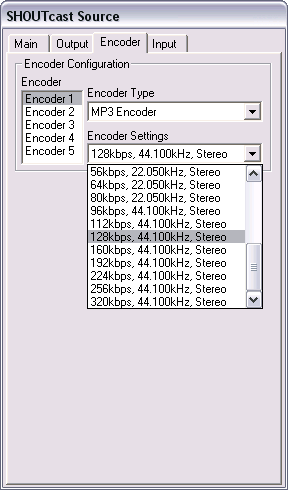
Encoder
Input

Если
Вы
планируете
вещать
только
фонотеку из mp3
файлов, то в Input Device
оставьте
плейер WinAMP. При
этом,
настройка
плагина будет
завершена
полностью и
готова к
эксплуатации.
Если же,
вещание
планируется
с другого источника
(магнитофона,
внешнего CD
проигрывателя,
FM тюнера и т.п.),
то выберите Soundcard Input
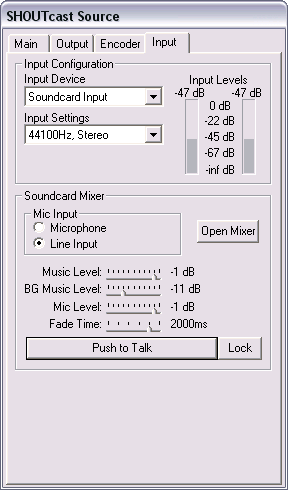
Open Mixer Push to Talk
|
Music Level | |
|
BG Music Level | |
|
Mic Level | |
|
Fade Time |
Push to Talk. В этот момент, громкость фонограммы снижается до установленного Вами уровня, одновременно поднимая уровень громкости микрофона. При этом фонограмма будет звучать, но гораздо тише, а ваш голос будет с нормальной эфирной громкостью наложен на нее. При отжатии этой кнопки, произойдет противоположный эффект, плавно поднимающий громкость фонограммы и снижающий громкость микрофона. Так сказать, полноценный миниатюрный автоматизированный пульт DJ на радиостанции.

Обратите
внимание, что
лог,
ведущийся
внутри окна
стал
увеличиваться.
В нем
отразились данные
о
подключении
и настройки
плагина-транслятора
Вашего WinAMP-а. В
правом
нижнем углу
помимо даты и
времени, у
Вас
показывается
количество
подключенных
пользователей
из
максимально
допустимого.
Все готово к
работе! Но,
никого нет...
И, пока что, не
будет...
Запустите
браузер и
введите свой
IP адрес, либо
имя Вашего
компьютера в
сети с
указанием
порта.
В моем случае
это выглядит
так:
|
С указанием IP |
https://192.168.0.1:8000 |
|
https://Null:8000 |
Внимание! Подстановка https:// в наборе обязательна! Без нее веб-интерфейс попросту не запустится!
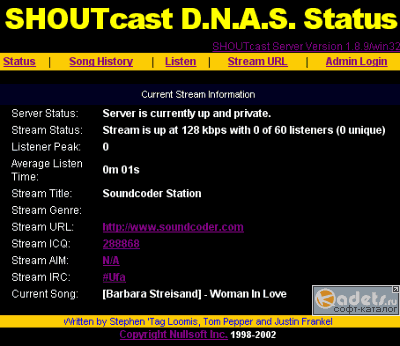
Admin Logon
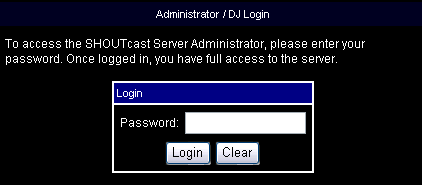
Если
Вы не помните
пароля, то
читайте эту
статью
заново. хехе!
Если же Вы
внимательный
и достойный
ученик -
вводите
пароль и
получите
доступ к
ресурсам
статистики
посещений,
разрешениям/запретам
определенным
пользователям
на прослушивание
своего
канала и
многого
другого...
С запретом
прослушивания,
перед
создателями
сего
продукта я
снимаю шляпу!
Представьте
на моментик,
что на работе
сложилась ситуация,
что
большинству
сотрудников
(которые
могут
работать в
наушниках),
захотелось прослушать
Вашу
эксклюзивную
коллекцию Сектора
Газа, Красной
Плесени, Шуры
Каретного
или... да мало
ли чего...
всякое
бывает.
Вы
быстренько
лезете в
админовский
веб-интерфейс
(замечу -
абсолютно с
любого
компьютера) и
ставите бан
на IP компиков
босса и бюстгалтерии.
Это я привожу
к примеру...
Так вот, они
логинятся, а
в ответ -
тишина... т.е.
пока что им
слушать
низзя... хехе!...
Впоследствии,
бан с них
можно снять
тем же способом.
net send Плагин к WinAMP никому раздавть НЕ НАДО!
https://192.168.0.1:8000/listen.pls
при этом на
данном
компьютере
автоматически
запустится WinAMP
- запуск из
плейера - в
пункт Add URL https://192.168.0.1:8000 Все,
процесс
пошел! Только
по личному
опыту, на
всякий
случай,
предупрежу -
не давайте IP
адрес, а
лучше
укажите
сетевое имя
компьютера
на котором
установлена
серверная
часть.
Кстати,
воспроизводящая
DJ станция (WinAMP
плагином)
может быть на
Вашем, а
серверная
часть стоять
на абсолютно
другом
компьютере .
Если там, где
Вы работаете
есть
настоящий сервер
и админ, то
лучше
договриться
с ним на
установку
серверной
части на
конторском сервачке.
Этим Вы
можете стать
для всех
"невидимкой",
да и админ
лучше позаботится
в
распределении
сетевых
ресурсов и
безопасности
Вашего
проекта.
На случай,
если сервер
организации
создан на
основе Linux или
другой
платформы, не
беда, на сайте
изготовителя
есть
серверные
компоненты практически
под любые
операционные
системы.
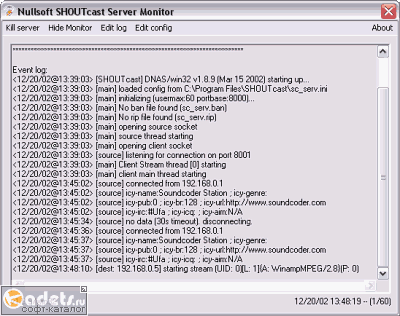
В
данном
случае мы
видим (в
правом
нижнем углу),
что один
клиент из 60
возможных
сидит на связи.
В логе
показан и его
IP адрес - 192.168.0.5.
Теперь можно
успокоиться,
закрыть
сервер (он не
прекратит
работу, а
просто
смоется в трей,
чтобы никому
не мешать) и
приступать к
составлению
супер-пупер плей-листа
для
всеобщего
признания.
Вот в
принципе и
все... Вся эта
канитель
настраиваема
(с учетом
инсталляций)
в течении 3 - 5 минут.
Но! Когда
умеешь и
знаешь. хехе...
128kbs - stereo
128 kbs -
излишество.
Для
уменьшения
битрейта без
потери качества
можно
воспользоваться
mp3PRO кодером
вместо
обычного mp3 (MPEG 1, 2, 2.5 layer 3).
Чтобы вещать
на реальные 128 kbs
обычного mp3,
достаточен
битрейт в 64 - 96 kbs mp3PRO.
А тем, кто
слушает
инет-радио,
рекомендую к
WinAMP-у
прикрутить
плагин mp3Pro
И еще немаловажный факт для Инет-радиостанции - вещать желательно только в определенном музыкальном направлении, дабы была своя постоянная аудитория. Это неписанный "кодекс чести" онлайновых радиостанций.
Напоследок, напутственная информация - так как в рейтинге SHOUTcast.com, огромнейшее количество всевозможных вещательных точек и быть замеченным чрезвычайно сложно (если не сказать, что у новых станций шанс равен нулю).
e mail: [email protected]
; SHOUTcast Distributed Network Audio Server configuration file
; Copyright (C) 1998-2004 Nullsoft, Inc.
; All Rights Reserved.
; Last modified Mar 17 2004
; If you want to manage multiple configurations, just copy
; this file to another name, and run sc_serv with that name
; such as:
; sc_serv.exe sc_leet.conf
; Required stuff
; MaxUser. The maximum number of simultaneous listeners allowed.
; Compute a reasonable value for your available upstream bandwidth (i.e. if
; you have 256kbps upload DSL, and want to broadcast at 24kbps, you would
; choose 256kbps/24kbps=10 maximum listeners.) Setting this value higher
; only wastes RAM and screws up your broadcast when more people connect
; than you can support.
MaxUser=10
; Password. While SHOUTcast never asks a listener for a password, a
; password is required to broadcast through the server, and to perform
; administration via the web interface to this server. This server should
; consist of only letters and numbers, and is the same server your broadcaster
; will need to enter in the SHOUTcast Source Plug-in for Winamp. THIS VALUE
; CANNOT BE BLANK.
Password=Shabardin1911987
; PortBase. This is the IP port number your server will run on. The
; value, and the value + 1 must be available. If you get a fatal error when
; the DNAS is setting up a socket on startup, make sure nothing else on the
; machine is running on the same port (telnet localhost portnumber -- if you
; get connection refused then you're clear to use that port). Ports < 1024
; may require root privledges on *nix machines. The default port is 8000.
PortBase=8000
; Optional Parameters
; Logging configuration
; LogFile: file to use for logging. Can be '/dev/null' or 'none'
; or empty to turn off logging. The default is ./sc_serv.log
; on *nix systems or sc_serv_dir\sc_serv.log on win32.
; Note: on win32 systems if no path is specified the location is
; in the same dir as the executable, on *nix systems it is in the
; current directory.
LogFile=sc_serv.log
; RealTime displays a status line that is updated every second
; with the latest information on the current stream (*nix and win32
; console systems only)
RealTime=1
; ScreenLog controls whether logging is printed to the screen or not
; on *nix and win32 console systems. It is useful to disable this when
; running servers in background without their own terminals. Default is 1
ScreenLog=1
; ShowLastSongs specifies how many songs to list in the /played.html
; page. The default is 10. Acceptable entries are 1 to 20.
ShowLastSongs=10
; TchLog decides whether or not the DNAS logfile should track yp
; directory touches. Adds and removes still appear regardless of
; this setting.
; Default is yes
; TchLog=yes
; WebLog decides whether or not hits to https:// on this DNAS will
; be logged. Most people leave this off because the DSP plug-in
; uses https:// calls to update titles and get the listener count,
; which takes up a lot of log space eventually. If you want to
; see people making hits on your admin.cgi or index pages, turn
; this back on. Note that this setting does NOT affect XML stats
; counters for hits to https:// pages.
; Default is no.
; WebLog=no
; W3CEnable turns on W3C Logging. W3C logs contain httpd-like accounts
; of every track played for every listener, including byte counts those listeners
; took. This data can be parsed with tools like Analog and WebTrends, or given
; to third parties like Arbitron and Measurecast for their reporting systems.
; Default is Yes (enabled).
W3CEnable=Yes
; W3CLog describes the name of the logfile for W3C logging. Default logfile is
; sc_w3c.log, in the same directory wherever the DNAS gets started from.
W3CLog=sc_w3c.log
; Network configuration
; SrcIP, the interface to listen for source connections on (or to make relay
; connections on if relaying). Can and usually will be ANY or 127.0.0.1
; (Making it 127.0.0.1 will keep other machines from being able to
; broadcast using your shoutcast server )
SrcIP=ANY
; DestIP, IP to listen for clients on (and to contact yp.shoutcast.com)
; can and usually will be be ANY. If your machine has multiple IP addresses,
; set this to the one you want it to be accessed by.
DestIP=ANY
; Yport, port to connect to yp.shoutcast.com on. For people behind caching
; webproxies, change this to the alternate port (666 is what it might be,
; check www.shoutcast.com if you have problems). Otherwise, leave this at 80.
; We're actively working on re-opening port 666, but as of release the only
; working port is port 80.
Yport=80
; NameLookups. Specify 1 to perform reverse DNS on connections.
; This option may increase the time it takes to connect to your
; server if your DNS server is slow. Default is 0 (off).
NameLookups=0
; RelayPort and RelayServer specify that you want to be a relay server.
; Relay servers act as clients to another server, and rebroadcast.
; Set RelayPort to 0, RelayServer to empty, or just leave these commented
; out to disable relay mode.
; RelayPort=8000
; RelayServer=192.168.1.58
; Server configuration
; AdminPassword. This password (if specified) changes the
; behavior of Password to be a broadcast-only password, and
; limits HTTP administration tasks to the password specified
; here. The broadcaster, with the password above, can still
; log in and view connected users, but only the AdminPassword
; will grant the right to kick, ban, and specify reserve hosts.
; The default is undefined (Password allows control for both
; source and admin)
; AdminPassword=adminpass
; AutoDumpUsers controls whether listeners are disconnected if the source
; stream disconnects. The default is 0.
AutoDumpUsers=0
; AutoDumpSourceTime specifies how long, in seconds, the source stream is
; allowed to be idle before the server disconnects it. 0 will let the source
; stream idle indefinately before disconnecting. The default is 30.
AutoDumpSourceTime=30
; ContentDir specifies the directory location on disk of where to stream
; on-demand content from. Subdirectories are supported as of DNAS 1.8.2.
; Default is ./content, meaning a directory named content in the same directory
; as where sc_serv was invoked from.
; ContentDir=./content
; IntroFile can specify a mp3 file that will be streamed to listeners right
; when they connect before they hear the live stream.
; Note that the intro file MUST be the same samplerate/channels as the
; live stream in order for this to work properly. Although bitrate CAN
; vary, you can use '%d' to specify the bitrate in the filename
; (i.e. C:\intro%d.mp3 would be C:\intro64.mp3 if you are casting at 64kbps).
; The default is no IntroFile
; IntroFile=c:\intro%d.mp3
; BackupFile can specify a mp3 file that will be streamed to listeners over
; and over again when the source stream disconnects. AutoDumpUsers must be
; 0 to use this feature. When the source stream reconnects, the listeners
; are rejoined into the live broadcast.
; Note that the backup file MUST be the same samplerate/channels as the
; live stream in order for this to work properly. Although bitrate CAN
; vary, you can use '%d' to specify the bitrate in the filename
; (i.e. C:\backup%d.mp3 would be C:\backup32.mp3 if you are casting at 32kbps).
; The default is no BackupFile
; BackupFile=C:\intro%d.mp3
; TitleFormat specifies a format string for what title is sent to the listener.
; For example, a string of 'Justin Radio' forces the title 'Justin Radio' even
; when the source changes the title. You can use up to one '%s' in the string
; which lets you contain the title from the source. For example, if your
; TitleFormat is 'Justin Radio: %s', and the source plug-in's title is
; 'Billy plays the blues', then the net title is
; 'Justin Radio: Billy plays the blues'. Note: only works on non-relay servers.
; The default is no format string.
; TitleFormat=Justin Radio: %s
; URLFormat specifies a format string for what url is sent to the listener.
; Behaves like TitleFormat (see above).
; The default is no format string.
; URLFormat=https://www.server.com/redirect.cgi?url=%s
; PublicServer can be always, never, or default (the default, heh)
; Any setting other than default will override the public status
; of the source plug-in or of a SHOUTcast server that is being relayed.
PublicServer=default
; AllowRelay determines whether or not other SHOUTcast servers will be
; permitted to relay this server. The default is Yes.
AllowRelay=Yes
; AllowPublicRelay, when set to No, will tell any relaying servers not
; to list the server in the SHOUTcast directory (non-public), provided
; the relaying server's Public flag is set to default. The default is
; Yes.
AllowPublicRelay=Yes
; MetaInterval specifies how often, in bytes, metadata sent.
; You should really leave this at the default of 8192, but the option is
; provided anyway.
MetaInterval=8192
; Access Control
; ListenerTimer is a value in minutes of maximum permitted time for
; a connected listener. If someone is connected for longer than this
; amount of time, in minutes, they are disconnected. When undefined,
; there is no limit defined. Default is undefined.
; ListenerTimer=600
; BanFile is the text file sc_serv reads and writes to/from
; for the list of clients prohibited to connect to this
; server. It's automatically generated via the web
; interface.
; BanFile=sc_serv.ban
; RipFile is the text file sc_serv reads and writes to/from
; for the list of client IPs which are *ALWAYS* permitted
; to connect to this server (useful for relay servers).
; This file is automatically generated via the web
; interface. Note that if your server is FULL, and someone
; from a Reserved IP connects, the DNAS will force the person
; listening for the longest time off to make room for the new
; connection.
; RipFile=sc_serv.rip
; RIPOnly, when set to Yes, will only allow IP addresses listed in the Reserved
; IP list to connect and relay. All other connections for listening will be denied.
; This is really only useful for servers whose sole purpose is to provide the
; primary feed to all public relays. Setting this value to Yes also forces the
; server into Private mode, since listing this server in the directory would
; be pointless. Default is No.
; RIPOnly=No
; Extended Logging
; The old features previously at this location, HistoryLog and CurrentLog, are
; no longer used and succeded by W3C Logging and XML, respectively.
; Mass Configuration
; Unique: assigns a variable name for use in any config item which points to a
; file. Useful for servers running lots of SHOUTcast servers that have similar
; configuration parameters, excepting logfile names, banfile names, etc. Any
; parameter that takes a pathname can include the character $, which will
; substitute $ for the variable assigned here. Keep in mind that the unique
; variable can only be used after it is defined, so don't try to use a unique
; variable substitution in a path before you define it. For example, you
; could set:
; Unique=my_server
; and then define Log=/usr/local/shoutcast/$.log in an included configuration
; file. Default is Unique=$, so that by default any file with $ in the name
; won't substitute anything at all.
; Include: instructs the sc_serv to read from the named configuration file,
; *at the point of insertion of the Include statement*, and process as though
; the included file was part of itself. Note that all configuration parameters
; in the DNAS config file are processed first to last, so if an item is defined
; twice in a configuration, the last item to process will be the one that takes
; effect. For this reason, it's usually a good idea to use the Includes first
; in a config file.
; example:
; Include=/usr/local/shoutcast/common.conf
; Default is not applicable.
; Tweaks
; DON'T MESS WITH THIS STUFF UNLESS YOU REALLY KNOW WHAT YOU'RE DOING.
; DON'T COMPLAIN TO US IF YOU MESS WITH IT AND THINGS BREAK.
; HAVE A NICE DAY.
; CpuCount is used to explicitly limit the DNAS to dominating a finite
; amount of processors in multiprocessor systems. By default,
; SHOUTcast creates one thread for every processor it detects in the
; host system, and assigns listeners equally across all the threads.
; In the event SHOUTcast doesn't correctly determine the number of
; CPUs in your host, or if you for whatever reason want to force
; the DNAS to not use other processors, you can say so here.
; Default behavior is to use as many processors as the DNAS detects on
; your system.
; CpuCount=1
; Sleep defines the granularity of the client threads for sending data.
; DNAS 1.7.0, per client thread, will send up to 1,024 bytes of data
; per socket (or less depending on the window available), and then
; sleep for the provided duration before repeating the whole process.
; Note that making this value smaller will vastly increase CPU usage on
; your machine. Increasing reduces CPU, but increasing this value too far
; will cause skips. The value which seems most optimal for 128kbps
; streaming is 833 (833 microseconds per client poll) on our test labs.
; We wouldn't recommend setting it any lower than 100, or any higher than
If you have a slower machine, set this number lower to fix
; skips.
; Default value is 833.
; Sleep=833
; CleanXML strips some whitespace and linefeeds from XML output which
; confuses some (poorly written) XML parsers. If you get XML rendering errors,
; try turning this on. Default is No (off).
; CleanXML=No
; TAG RULES
|